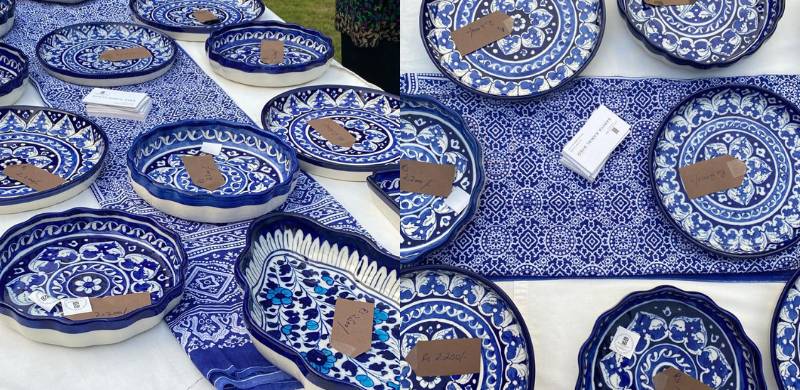
It's impossible to think of Multan without thinking of the trademark blue and white ceramics known as Multani blue pottery, and Saniya Syed of Sania's Cultural Express (SCE) is doing her part in making sure the rest of the world appreciates the beauty of this decades old craft.
After a series of successful exhibitions around the world in places like Rome, London, and Dubai, Saniya finally held a blue pottery exhibition in Lahore on Saturday.
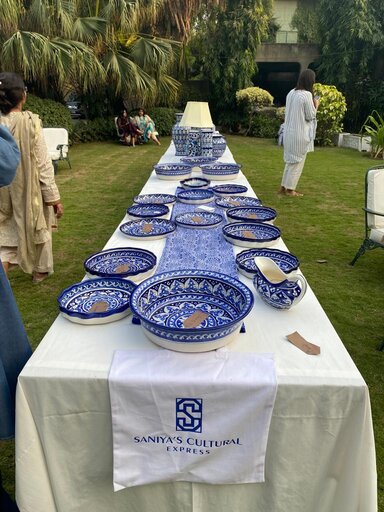
The exhibition took place at a family home, where upon entering the tree shrouded garden, visitors were immediately drawn towards a large table laden with bowls, plates and lamps of various sizes, each a striking shade of blue. The exhibition was held in collaboration with Sunbeam schools, with 15% of the proceeds going to the school towards the education of the underprivileged. As a collaboration and to encourage local cuisine, delicious food was offered by Hot & Spicy.
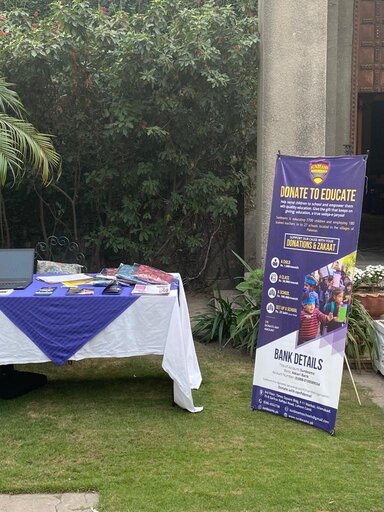
Saniya's Cultural Express was set up in 2020, as a partnership with the Lahore Biennale Foundation, as a means of hosting international guests during the Biennale. SCE also hosts a number of cultural trails, which are themed tours, highlighting the history and culture of the country.
"After 2020 Covid happened, so travelling became impossible, which is when my close friend, and perhaps the spirit of Saniya's Cultural Express Mehreen Rizvi, she prompted me to bring Pakistani culture and arts to the UK," Saniya told The Friday Times.
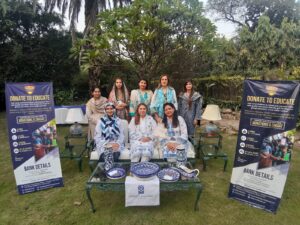
Multani Blues under the SCE umbrella was launched in July 2021 in London where the Pakistani High Commissioner HE Mr Moazzam Ahmed Khan was the Chief guest at the inauguaration. Since then Saniya has showcased this craft globally.
She held an exhibition in Dubai with SoPritti in October 2021, in Rome with the support of Cricolo Della Colonne in April 2022 and in London for the Queen's Coronation which was a collaboration with Aiza Loves Cooking, featuring edibles with the British flag to celebrate UK-Pakistan relations. In Pakistan she held an exhibition in Islamabad and now in Lahore.
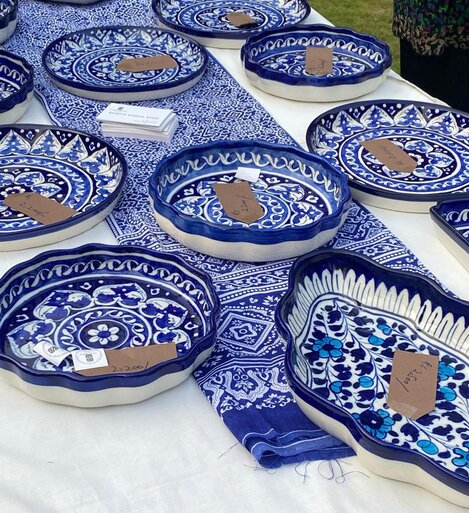
"These are actually very old designs that have been recreated by the local artisans over centuries," she tells TFT, adding, "The shades of blue and turqouise have always been the essence of all the bazaars and darbars in the Islamic world, and that is where we take our inspiration from."
The vibrant blue and white pottery of current day Multan descends from an artistic tradition which produced the exquisite tiles of the Mausoleum of Bahauddin Zakariya and the Tomb of Shah Rukh-e-Alam.
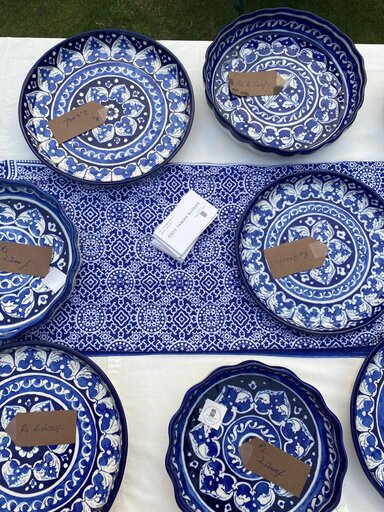
Multani pottery is identifiable by its use of floral motifs and geometrical patterns in vivid blues and whites. The blue colour prepared from cobalt oxide and copper oxide using a special technique gives kashigari its distinctive look. Trade secrets about colour combinations as well as patterns have been passed down family lines of prominent artisans.
Traditionally, red clay from the Indus river was popular in the production of pottery in the region. Today more work is done in ceramics rather than terracotta. Plates with tiny jharokha decorated rims and floral motifs carry faint echoes of the silk road.
After a series of successful exhibitions around the world in places like Rome, London, and Dubai, Saniya finally held a blue pottery exhibition in Lahore on Saturday.

The exhibition took place at a family home, where upon entering the tree shrouded garden, visitors were immediately drawn towards a large table laden with bowls, plates and lamps of various sizes, each a striking shade of blue. The exhibition was held in collaboration with Sunbeam schools, with 15% of the proceeds going to the school towards the education of the underprivileged. As a collaboration and to encourage local cuisine, delicious food was offered by Hot & Spicy.

Saniya's Cultural Express was set up in 2020, as a partnership with the Lahore Biennale Foundation, as a means of hosting international guests during the Biennale. SCE also hosts a number of cultural trails, which are themed tours, highlighting the history and culture of the country.
"After 2020 Covid happened, so travelling became impossible, which is when my close friend, and perhaps the spirit of Saniya's Cultural Express Mehreen Rizvi, she prompted me to bring Pakistani culture and arts to the UK," Saniya told The Friday Times.

Multani Blues under the SCE umbrella was launched in July 2021 in London where the Pakistani High Commissioner HE Mr Moazzam Ahmed Khan was the Chief guest at the inauguaration. Since then Saniya has showcased this craft globally.
She held an exhibition in Dubai with SoPritti in October 2021, in Rome with the support of Cricolo Della Colonne in April 2022 and in London for the Queen's Coronation which was a collaboration with Aiza Loves Cooking, featuring edibles with the British flag to celebrate UK-Pakistan relations. In Pakistan she held an exhibition in Islamabad and now in Lahore.
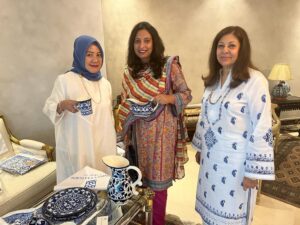 What makes 'Multani Blues' stand out is quality control. Saniya says quality is something she is not willing to compromise on, and makes sure that each of the pieces she curates are free from air bubbles, chips, accidental ink spills or misprints. And the detail and neatness in the pieces really show.
What makes 'Multani Blues' stand out is quality control. Saniya says quality is something she is not willing to compromise on, and makes sure that each of the pieces she curates are free from air bubbles, chips, accidental ink spills or misprints. And the detail and neatness in the pieces really show.

"These are actually very old designs that have been recreated by the local artisans over centuries," she tells TFT, adding, "The shades of blue and turqouise have always been the essence of all the bazaars and darbars in the Islamic world, and that is where we take our inspiration from."
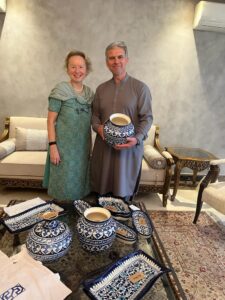
The vibrant blue and white pottery of current day Multan descends from an artistic tradition which produced the exquisite tiles of the Mausoleum of Bahauddin Zakariya and the Tomb of Shah Rukh-e-Alam.

Multani pottery is identifiable by its use of floral motifs and geometrical patterns in vivid blues and whites. The blue colour prepared from cobalt oxide and copper oxide using a special technique gives kashigari its distinctive look. Trade secrets about colour combinations as well as patterns have been passed down family lines of prominent artisans.
Traditionally, red clay from the Indus river was popular in the production of pottery in the region. Today more work is done in ceramics rather than terracotta. Plates with tiny jharokha decorated rims and floral motifs carry faint echoes of the silk road.

